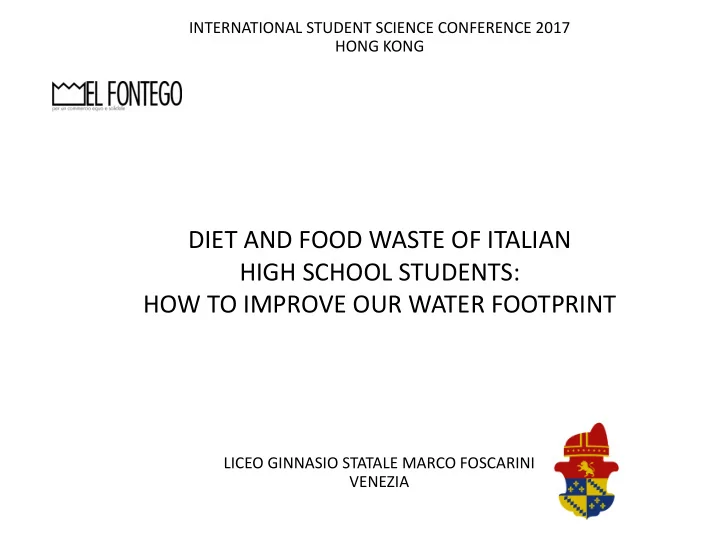

INTERNATIONAL STUDENT SCIENCE CONFERENCE 2017 HONG KONG DIET AND FOOD WASTE OF ITALIAN HIGH SCHOOL STUDENTS: HOW TO IMPROVE OUR WATER FOOTPRINT LICEO GINNASIO STATALE MARCO FOSCARINI VENEZIA
WHAT IS THE WATER FOOTPRINT? The water footprint (WF) measures the amount of water used to produce each of the goods and services we use. Potato WF : 290 L/Kg =10 L
WATER CRISIS Globally In Italy
We wanted to focus on the water used in food production In agriculture In breeding
And in industrial food processing We have thus analysed the impact that our diet has on water consumption
How much does our diet influence our water consumption? That is the water needed to fill about 150 bath tubs! To produce one kilogram of red meat 15415 litres of water are needed
HOW DID WE PROCEED? Bibliographic research Data Collection Data processing
THE SURVEY DISCOVERING THE EATING HABITS OF OUR SCHOOLMATES We wrote a survey to ask how many times a given food was consumed per day or week and we submitted it to 160 students in our school
DATA ANALYSIS We looked for the water footprint of the foods we were interested in 214 L/Kg 255 L per 250 ml 15415 L/Kg
We calculated the water footprint of the various recipes Vegetables 6 L Pasta 112 L Pasta with meat sauce* Tomato sauce 35 L Oil 85 L 1158 L Beef 770 L Pork 150 L *a portion of 90g
DATA ANALYSIS Determine the average consumption by our schoolmates for food A (g/week) Average consumption of food A (g/week) x WF of food A (L/g) = contribution of food A to our average WF (L/week) Sum of all contributions of food A, B, C... in our diet = Total average WF (L/week)
RESULTS The diet of an average student in our school costs 27079 litres of water per week Foods that consume most water in a week are: Red meat 6009 L Dairy products and eggs Carbohydrates 6691 L 4283 L
Having discovered our weekly water consumption, we asked ourselves: Could we change our diet to reduce its water footprint?
Living in Italy, we decided to analyse the water footprint of the Mediterranean diet
THE MEDITERRANEAN DIET A COMPARISON Following the Mediterranean diet, a single person consumes about 22760 litres of water per week Italian students could save more than 4000 litres of water per week each, changing a few things in their diet For example: The WF of chicken meat is 4325 L/Kg. The Mediterranean diet includes 1 portion of red meat and 4 of white meat per week
ANALYSIS OF THE CANTEEN MENU HOW MUCH DO STUDENTS EAT? HOW MUCH DO THEY THROW AWAY? We have been monitoring for a week a class of 13 during lunchtime in the school canteen thrown away portions (110) eaten portions (131) 26790 L 37787 L
CONCLUSIONS It is not easy to preserve water resources, but it is possible. We could protect our main source of life just by being more aware of what we eat and its impact on the world we live in. Small changes today, big changes in the future.
SOURCES • http://waterfootprint.org/en/water-footprint/what-is-water-footprint/ • http://www.fao.org/nr/sustainability/en/ • http://www.fao.org/docrep/018/i3347e/i3347e.pdf • http://pubs.sciepub.com/jfnr/1/4/5/ • http://www.wwf.it/news/pubblicazioni/?6785/Impronta-idrica-dellItalia • http://www.sinu.it/html/pag/07-PROTEINE.asp •http://www.sinu.it/html/pag/03 -Fabbisogno-energetico-medio-AR-in-eta-adulta.asp • http://nut.entecra.it/646/tabelle_di_composizione_degli_alimenti.html •http://waterfootprint.org/media/downloads/Hoekstra -2008-WaterfootprintFood.pdf • D.Vanham, A.Y.Hoekstra, G.Bidoglio , “Potential water saving through changes in European diets” Environment International, Volume 61, November 2013, Pages 45 -56 • https://www.ncbi.nlm.nih.gov/pubmed/26258557 Pahlow M, van Oel PR, Mekonnen MM, Hoekstra A , “ Increasing pressure on freshwater resources due to terrestrial feed ingredients for aquaculture production” Science of the Total Environment 536 (2015) 847– 857
ACKNOWLEDGEMENTS and gratitude to those who partecipated in this project: - Massimo Zane – Principal Liceo Classico Europeo M.Foscarini - Caterina Rossi – Science Teacher at Liceo Classico Europeo M.Foscarini - Eugenia Iovane – Science Teacher at Liceo Classico Europeo M.Foscarini - Angelo F. Paloschi – Science Teacher at Liceo Classico Europeo M.Foscarini - El Fontego – Venetian fairtrade cooperative - Mrs. Nicoletta Zanon – Voluntary worker at El Fontego cooperative - Alice Laggia – Student at Liceo Classico Europeo M.Foscarini - Eric Ho – Administration Executive at the Community Relations Office of the St. Paul’s co -educational College … and everyone who assisted us in our reseach
OUR GROUP Manola Bonsignore, 5BO Nina Cerasuolo, 2AE Pierpaolo Fasolo, 2BE Nicolò Ferretti, 2EE Elena Gianola, 5AO Nicolò Giuntoli, 2CE Carlotta Pompei, 2CE Susanna Savini, 2DE Anna Collarin, Science teacher Alvise Varagnolo, Mathematics and Physics teacher
Recommend
More recommend